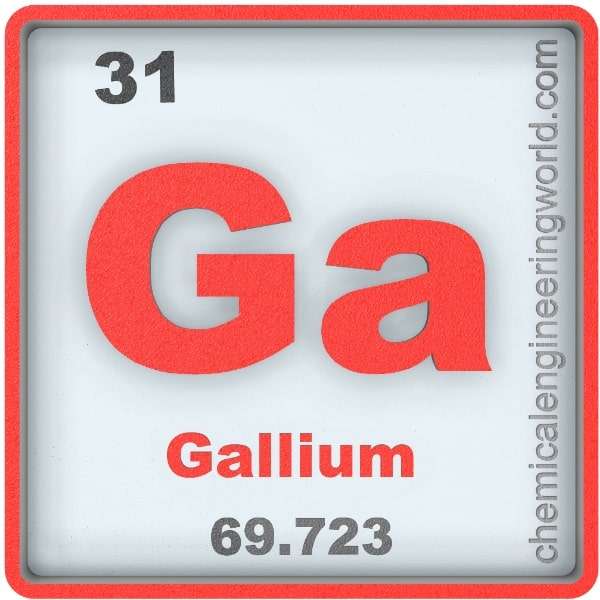Gallium Element Properties and Information

Gallium Element Properties and Information
Gallium is the thirty-first element on the periodic table. Elements are arranged in the periodic table on the basis of the atomic number. Atomic number is the number of protons in the nucleus of the atom. Gallium has an atomic number of 31. It is located in the Group 13 and Period 4 of the periodic table of elements. It is denoted by Ga. The name is derived from the Latin name of France ‘Gallia’.
Mendeleev observed the periodic table and saw that there is a gap below aluminium. He predicted that the missing element must have atomic weight of around 68 and density would be around 5900 in S.I. units. Paul-Émile Lecoq de Boisbaudran observed a new violet line in zinc which he extracted from a zinc blende ore. He understood that it signified that an unknown element is present. He isolated and purified the new metal, it was like aluminium. Later it was named Gallium and placed in exactly the same location as predicted by Mendeleev.
Gallium is not found in nature as an element. It is present in trace amounts in combined form in minerals like germanite, bauxite, diaspore, sphalerite, and coal.
Physical Properties
- Gallium is soft silvery-white metal.
- The atomic mass of gallium is 69.72
- The melting point of gallium is 29.8°C
- The boiling point of gallium is 2204°C
- The density of gallium is 7110 in S.I. units at 20°C
- Gallium liquid expands by about 3% of its original volume after it gets solidified.
- Gallium melts if held in hand because body temperature is greater than the melting temperature of the element.
- Gallium is one of the four non-radioactive metals which are known to be liquids at room temperature. Other three are mercury, caesium, and rubidium.
- Gallium has 31 known isotopes among which only two isotopes occur naturally; gallium-69 and gallium-71. Among all the isotopes, gallium-69 is the most abundant as it makes up to 60.1% of the total gallium.
Chemical Properties
- If gallium is exposed to air then it forms a passivation layer.
- Gallium compounds are commonly found in +3 oxidation state. Gallium compounds in +1 oxidation states are also known but they are relatively less common.
- Strong acids easily dissolve gallium thus forming gallium(III) compounds.
- Gallium hydroxide dissolves in alkali to form gallate salts.
Methods of Production
As by-product: Gallium is produced commercially as a by-product during the production of zinc or aluminium. Bauxite is processed by using Bayer’s process to obtain Alumina. During the process gallium accumulates in the sodium hydroxide liquor. A certain percentage of gallium is extracted from the sodium liquor by using ion exchange resins. The gallium is then removed from the ion exchange resin in the solution. Electrolysis is used to separate the gallium metal. If highly refined gallium metal is needed then zone melting is used further.
Relevance in Chemical and Related Industries
Alloys: Gallium is generally used as an ingredient in the low melting alloys.
Relevance in Other Industries
- Semiconductors: Majority of gallium, about 98% of which is produced commercially goes into the semiconductor industry. Gallium is used in the form of gallium arsenide and gallium nitride.
- Biomedical application: Gallium behaves in the body in manner similar to iron(III). These processes generally include inflammations which is a marker for several diseases hence gallium is used in pharmaceutical medicines. Gallium compounds are also added as an ingredient to treat the tumors and cancers associated with bones.
Health Effects on Exposure
Very large doses: Gallium compounds are not harmful in small doses. They start to show effect when the dosage is very large, for instance gallium(III) chloride can cause throat irritation, difficulty breathing, chest pain, pulmonary edema, and partial paralysis.
Effects on Surroundings
- Water pollution: Many nuclear bombs were produced during world war which was never used. Some of these are stored underground in nuclear bomb pits and gallium is used to hold the pits together. When time comes to cut open the pits in order to use the plutonium in the nuclear bomb as a fuel source then a problem arises that plutonium gets oxidised and gallium gets stuck inside it. The separation of gallium from plutonium is destructive to Earth because it causes enormous water pollution.
References:
https://en.m.wikipedia.org/wiki/Gallium
https://www.lenntech.com/periodic/elements/ga
https://www.rsc.org/periodic-table/element/31/gallium































